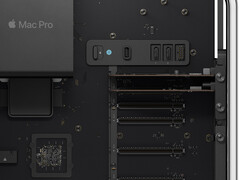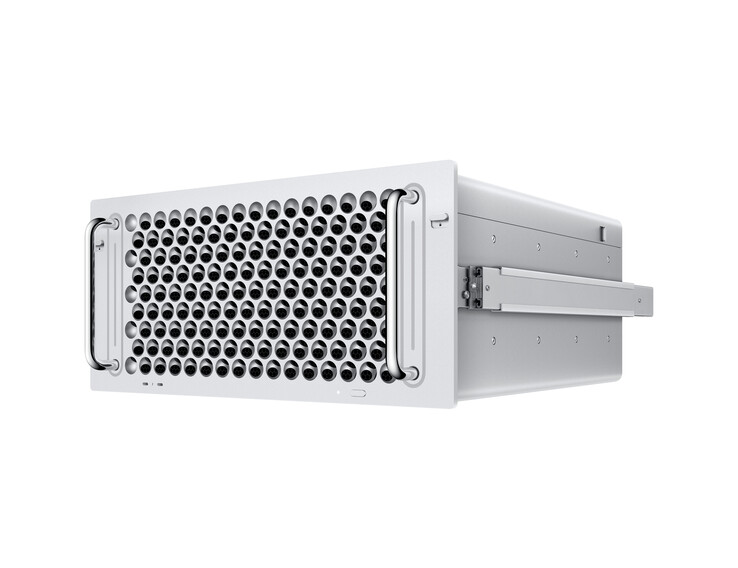Back in 2019, Apple managed to once again offer professional customers a flexible, configurable workstation by launching the last Intel-based Mac Pro. But the migration from Intel to Apple silicon is now complete with the new Mac Pro. Intel-based Macs are no longer available in Apple's online store. So it's time to take an in-depth look at the new workstation and compare it with its predecessor.
The old Mac Pro was so flexible that you could end up with a configuration costing way above €50,000 (US$53,640). This is perfect for generating headlines as well as fuelling the sentiment that Apple computers are simply expensive. But such prices are not that unusual: high-end workstations from Dell, HP and Lenovo can also cost up to mid five-figures if you spec them out.
This is no longer true for Apple workstations. Even the most expensive rack-mounted version will set you back only about €14,500 (US$15,557). The main components driving up prices are the RAM (€1,150 extra for 192 GB) and SSD (€2,530 extra for 8 TB). The former is no longer upgradeable (memory replacement guide for Mac Pro 2019), which is not something you see very often in a workstation.
The limited options also mean the maxed-out configuration now carries a smaller price tag. Those who need terabytes of RAM will need to get hold of an old Mac Pro with twelve DIMM slots or switch to a workstation made by other companies, since this is no longer possible with the new Mac Pro. Apple is taking a step backwards in the direction of the black cylinder Mac Pro.
As a result, the new Mac Pro has fewer differences from the Mac Studio, which itself is a taller Mac Mini. Some customers may not need the Mac Pro any more because the Mac Studio configured with an Ultra chip is cheaper whilst offering the same level of performance in some regards. Even the video encoder, media engine and number of displays supported are identical.
One important reason to go for the workstation: it can be upgraded with speedy PCIe cards. Six of the seven slots are gen 4, three of which offer a maximum of 16 lanes. The other three only have eight lanes.
No more graphics card upgrades
As usual, the PCIe cards have a maximum of 300 watts at their disposal. Based on the spec sheet, the aux power cable is compatible with the new Mac Pro as well. According to information obtained by Apple Insider, however, the new Mac Pro isn't going to support conventional graphics cards. Apple too only lists Radeon graphics cards (MPX modules) for the old Mac Pro and left the graphics section empty for the model with Apple silicon, meaning those wanting to use a fast and power-hungry graphics card don't even have to start thinking about power budget issues.
Of course, you'll still find professional cards, such as those used for Fibre Channel and RAID. However, there are limitations with regard to the number of displays supported. The Mac Pro can connect to multiple monitors despite the GPU limitation. Apple explicitly mentioned SDI display, for example. This is an aspect where the Mac Studio still struggles with.
That said, some cutbacks have been made in terms of display outputs. The old Mac Pro can drive up to twelve 4K displays, but the new model can handle no more than eight. On the other hand, the new Mac Pro is capable of outputting to six 6K displays – the previous version can only do 5K at best. This means the Mac Pro now boasts native support for XDR displays, whereas an MPX module was required previously. Another new feature is the support for up to three 8K displays.
Interestingly, Apple has carried over the I/O card design from the Intel-based machine. One of the PCIe slot is used to provide more ports and can be replaced if needed. Judging by pictures available, the new Mac Pro is going to offer a new set of I/Os via its four-lane PCIe 3.0 slot. The previous Intel-based model had an I/O card with two Thunderbolt 3 ports, two USB-A ports and an audio output. On the latest Mac Pro, the Thunderbolt ports have been replaced by HDMI ports with audio capabilities. The number of Thunderbolt 4 ports have also been increased to eight.
It seems Apple hasn't made any changes to the power supply. The system can draw up to 1,280 watts from the mains. So if you are planning to use the Mac Pro with several HDR displays and set up multiple work spaces, you really have to think about how to protect the mains circuit against overloading. Running these computers under full load can definitely be a challenge in an office setting.
Mac Studio takes on the mantle of Mac Pro
Overall, the Mac Pro remains the most flexible machine in the Mac lineup, especially given the fact that it has PCIe slots. That said, RAM flexibility takes a significant hit due to the unified memory design, in terms of both maximum capacity and upgradeability.
Soldered memory is something very rarely seen in workstations, particularly because it requires a customer to very carefully consider how much RAM they need over the lifespan of a device even before making a purchase. On top of that is the lack of support for MPX modules.
The Mac Studio is by and large taking on the mantle of the Mac Pro. Some observers already saw this coming when the Studio was unveiled. The times of fully upgradable Macs are over, and it is doubtful whether Apple will ever bring back this kind of flexibility, which, for all intents and purposes, already ended with the launch of the 2013 Mac Pro.





